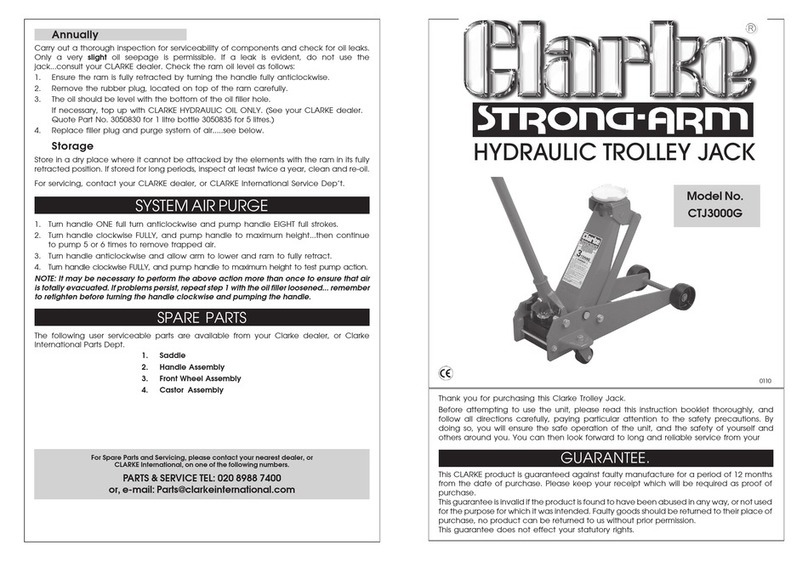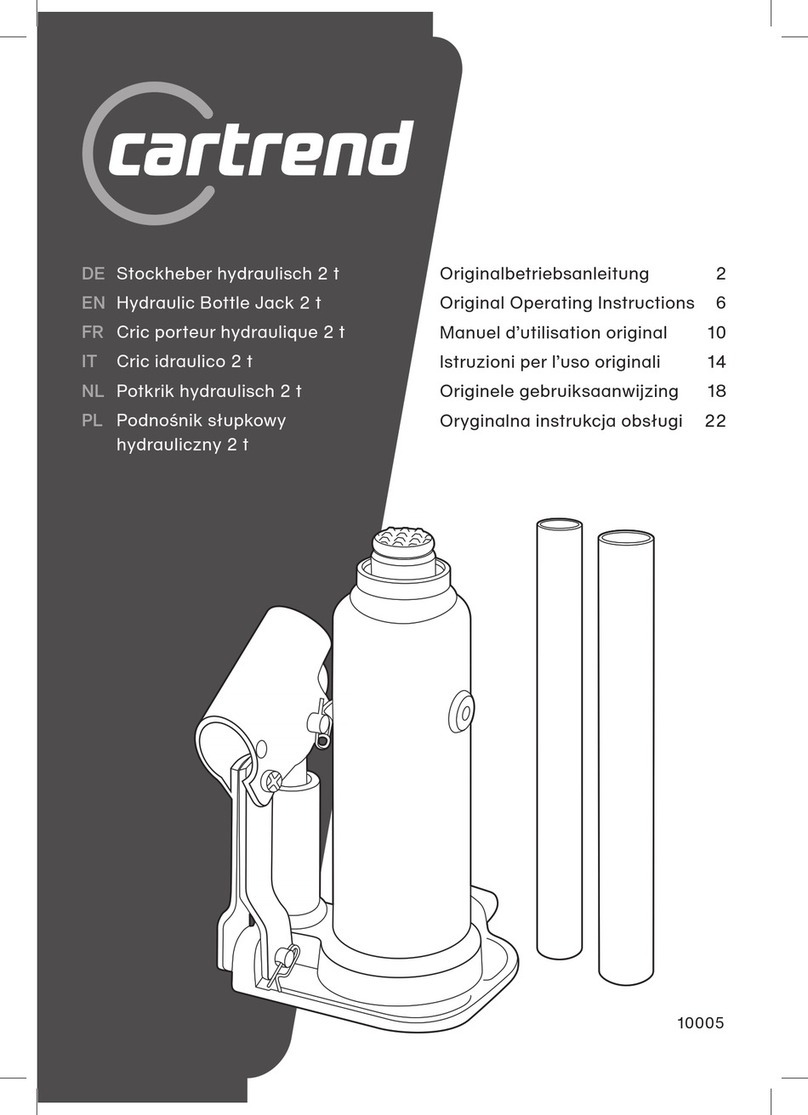
D
Hubhöhe mit Nennlast: 135 mm – 342 mm
Traglast: 2000 kg
Technische Daten...
1. Vor dem ersten Einsatz des Wagenhebers:
bei geöffnetem Ablassventil 1für Feststelleinrichtung den Griff
in die Griffhülse 2schieben und mit mindestens sechs kräftigen
Pumpbewegungen die Hydraulik betätigen und somit das Hydrauliköl gleichmäßig verteilen.
2. Zum Anheben der Last: Ablassventil durch Drehen im Uhrzeigersinn schließen . Darauf achten,
dass der Aufnahmebock 3mittig belastet wird. Anschließend Wagenheber betätigen .
3. Zum Ablassen der Last: Ablassventil 1durch Drehen gegen den Uhrzeigersinn langsam gerade so
weit öffnen, dass das Ventil geöffnet ist, sich aber nicht von dem Sockel löst.
Betrieb...
1. Im Interesse Ihrer eigenen Sicherheit den Wagenheber nicht
über die zulässige Traglast belasten.
2. Benutzen Sie den Wagenheber nicht unter folgenden Umständen:
- Unter erschwerten Bedingungen (z.B. sehr kaltes oder sehr heißes Klima, unter Beeinflussung
starker magnetischer Strahlung) und ähnlichen Situationen
- Im Zusammenhang mit explosiven Stoffen, Minen etc und ähnlichen Situationen.
-
Beim Lasten heben, die u.a. folgende Materialien enthalten: geschmolzenes Metall, Säure, radio-
aktives Material oder lose Güter, die nicht fest miteinander verbunden sind und ähnlichen Situationen.
- In Kontakt mit Lebensmitteln und ähnlichen Situationen.
- Auf Schiffen und ähnlichen Situationen.
3. Das Fahrzeug immer mit angezogener Handbremse anheben und gleichzeitig Unterlegkeile einset-
zen, um ein Wegrollen des Fahrzeugs zu verhindern.
4. Heben Sie niemals Personen mit dem Wagenheber an. Benutzen Sie den Wagenheber nicht, wenn
sich Personen im Fahrzeug befinden oder sich gegen das Fahrzeug lehnen.
5. Last immer im Mittelteil des Aufnahmebocks abstützen . Eventuell sind geeignete Adapter
zu verwenden, um Beschädigung der Aufnahmepunkte am Fahrzeug zu vermeiden. Bitte
Bedienungsanleitung des Fahrzeugherstellers beachten.
6. Das Sicherheitsventil ist werkseitig korrekt eingestellt und muss nicht nachjustiert werden.
7. Warnung: Der Wagenheber ist nur zur Hebung des Fahrzeuges gedacht. Vor Inspektions- und
Reparaturarbeiten muss die Last durch Hebeständer mit entsprechender Nennbelastung unter-
stützt werden. Nie unter der angehobenen Last ohne zusätzliche Stützen arbeiten!
8. Die Belastung des Hebers darf nicht über 2 Tonnen (4500 LBS) liegen, da bei einer Überbelastung
der Wagenheber beschädigt (z.B. Überlastung der mechanischen Eigenschaften) werden kann
und dadurch die Personensicherheit nicht mehr gewährleistet ist.
9. Bitte nur auf festem, ebenen Boden verwenden. Auf nicht befestigtem, unebenen Boden ist die
Stabilität nicht mehr gewährleistet und die Last kann verrutschen / beschädigt werden.
10. Wenn ein Ölleck auftritt, muss der Gebrauch gestoppt werden. Es ist dafür Sorge zu tragen, dass
kein weiteres Öl austritt und dass das bereits ausgetretene Öl umgehend aufgenommen und in
den dafür vorgesehenen Einrichtungen entsorgt wird.
11. Wenn die aufzubringende Handkraft mehr als 400 N (ca. 40 kg) beträgt, bitten wir Sie, eine zweite
Person zur Hilfe zu nehmen.
12. Man sollte den Zustand der Markierungen regelmäßig kontrollieren und sicherstellen, dass die
Markierungen den ursprünglichen entsprechen.
13. Überprüfen Sie den Wagenheber vor jedem Einsatz auf Beschädigungen, Öllecks, Korrosion.
Verwenden Sie den Wagenheber nicht, wenn er beschädigt ist. Der Wagenheber sollte gemäß
den Anweisungen des Herstellers gewartet und repariert werden. Solche Wartungen und
Reparaturen sollten nur von qualifizierten Fachkräften vorgenommen werden.
14. Umbau oder Änderungen, die die Konformität des Wagenhebers mir der Norm EN
1494:2000+A1:2008 auf schädliche Weise beeinflussen, dürfen nicht durchgeführt werden.
15. Es ist notwendig, dass der Bediener die Hebevorrichtung und die Last während aller Bewegungen
im Auge behält.
Zur Beachtung...
1
23
3
4
Angehobene Last immer zusätzlich mit Unterstellböcken abstützen.
Den hydraulischen Wagenheber niemals allein zur Lastabstützung
verwenden. Lesen Sie vor Inbetriebnahme sorgfältig die Bedienungs- und Wartungsanleitung.
Achtung...
7740014-AZ-Wagenheber-2000kg-CTR-IM-INT-OEF-180716.indd 6 16.07.18 14:31





























